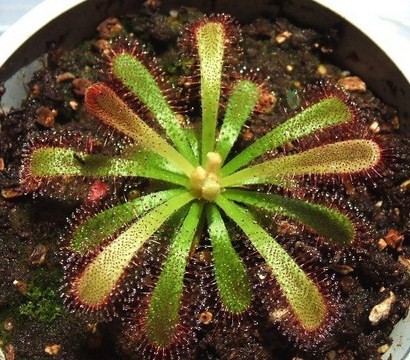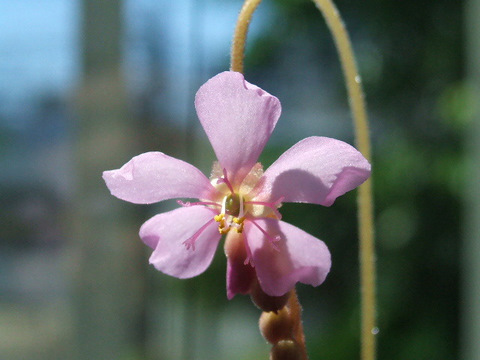Drosera capensis X aliciaeDrosera capensis X aliciae (or D. aliciae X capensis) plants are natural or artificial hybrids between D. capensis and D. aliciae (the name of the seed parent always comes first). These hybrids are mostly pale and unstable, but they will thrive and can aquire a vibrant orange-red coloration if given the proper conditions. |
|
 Drosera capensis x alciae
|
Media: this plant is not picky- many combinations can be used such as dry/live Long-Fibered sphagnum, 100% peat, or peat/sand mix, for example. In warmer climates, live sphagnum may work better. Media moisture: moist. Don't over-water. Humidity: very little is needed. Pot height: at least 7 cm (around 3 inches). Trapping speed: moderate to slow. Feeding: it would be ideal to feed it once every one-two weeks, but it is not mandatory. See feeding page. Food size: medium to small to avoid burning. Plant dimensions: approx. 7 cm (~3 inches) in diameter, but the plant size depends on those of the parents. Temperature: keep plant at approx. 22-27 degrees Celcius (70-80F) for ideal growth Lighting/Photoperiod: give 12 hours or more to maintain proper growth. (if using weak fluorescents, use a 15+ hour photoperiod.) Strong direct sunlight is likely to damage the plants (particularly in bright regions). Dormancy requirements: if given proper conditions, no dormancy is required. When the environment is not suitable (i.e. too cold or too hot), it can go dormant for months. Flowers: are intermediate form between those of the parents (D. capensis and D. aliciae). D. capensis x aliciae hybrids are usually sterile, so propagate via leaf or root cuttings. Propagation TechniquesSeed: is normally sterile. Leaf-cuttings: they slowly sprout from leaf cuttings. If you use fluorescents, place the leaves on water in a plastic container sealed with saran. If the leaves are kept only an inch away from the lights (or less), they will grow a bit faster. Root cuttings: are generally slower. Divisions: will form clumps over time. separate the clump when the shoots have matured. |
Additional Questions or Suggestions?
Contact me at: sundewman(at)yahoo.com
